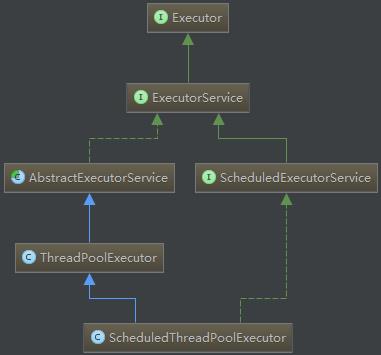java并发编程--Executor框架
Posted 龍清扬
tags:
篇首语:本文由小常识网(cha138.com)小编为大家整理,主要介绍了java并发编程--Executor框架相关的知识,希望对你有一定的参考价值。
摘要:
Eexecutor作为灵活且强大的异步执行框架,其支持多种不同类型的任务执行策略,提供了一种标准的方法将任务的提交过程和执行过程解耦开发,基于生产者-消费者模式,其提交任务的线程相当于生产者,执行任务的线程相当于消费者,并用Runnable来表示任务,Executor的实现还提供了对生命周期的支持,以及统计信息收集,应用程序管理机制和性能监视等机制。
1.Exexctor简介
Executor的UML图:(常用的几个接口和子类)

Executor:一个接口,其定义了一个接收Runnable对象的方法executor,其方法签名为executor(Runnable command),
ExecutorService:是一个比Executor使用更广泛的子类接口,其提供了生命周期管理的方法,以及可跟踪一个或多个异步任务执行状况返回Future的方法
AbstractExecutorService:ExecutorService执行方法的默认实现
ScheduledExecutorService:一个可定时调度任务的接口
ScheduledThreadPoolExecutor:ScheduledExecutorService的实现,一个可定时调度任务的线程池
ThreadPoolExecutor:线程池,可以通过调用Executors以下静态工厂方法来创建线程池并返回一个ExecutorService对象:
2.ThreadPoolExecutor构造函数的各个参数说明
ThreadPoolExecutor方法签名:
public ThreadPoolExecutor(int corePoolSize, int maximumPoolSize, long keepAliveTime, TimeUnit unit, BlockingQueue<Runnable> workQueue, ThreadFactory threadFactory, RejectedExecutionHandler handler) //后两个参数为可选参数
参数说明:
corePoolSize:核心线程数,如果运行的线程少于corePoolSize,则创建新线程来执行新任务,即使线程池中的其他线程是空闲的
maximumPoolSize:最大线程数,可允许创建的线程数,corePoolSize和maximumPoolSize设置的边界自动调整池大小:
corePoolSize <运行的线程数< maximumPoolSize:仅当队列满时才创建新线程
corePoolSize=运行的线程数= maximumPoolSize:创建固定大小的线程池
keepAliveTime:如果线程数多于corePoolSize,则这些多余的线程的空闲时间超过keepAliveTime时将被终止
unit:keepAliveTime参数的时间单位
workQueue:保存任务的阻塞队列,与线程池的大小有关:
当运行的线程数少于corePoolSize时,在有新任务时直接创建新线程来执行任务而无需再进队列
当运行的线程数等于或多于corePoolSize,在有新任务添加时则选加入队列,不直接创建线程
当队列满时,在有新任务时就创建新线程
threadFactory:使用ThreadFactory创建新线程,默认使用defaultThreadFactory创建线程
handle:定义处理被拒绝任务的策略,默认使用ThreadPoolExecutor.AbortPolicy,任务被拒绝时将抛出RejectExecutorException
3.Executors:提供了一系列静态工厂方法用于创建各种线程池
newFixedThreadPool:创建可重用且固定线程数的线程池,如果线程池中的所有线程都处于活动状态,此时再提交任务就在队列中等待,直到有可用线程;如果线程池中的某个线程由于异常而结束时,线程池就会再补充一条新线程。
方法签名:
public static ExecutorService newFixedThreadPool(int nThreads) { return new ThreadPoolExecutor(nThreads, nThreads, 0L, TimeUnit.MILLISECONDS, //使用一个基于FIFO排序的阻塞队列,在所有corePoolSize线程都忙时新任务将在队列中等待 new LinkedBlockingQueue<Runnable>()); }
newSingleThreadExecutor:创建一个单线程的Executor,如果该线程因为异常而结束就新建一条线程来继续执行后续的任务
方法签名:
public static ExecutorService newSingleThreadExecutor() { return new FinalizableDelegatedExecutorService //corePoolSize和maximumPoolSize都等于,表示固定线程池大小为1 (new ThreadPoolExecutor(1, 1, 0L, TimeUnit.MILLISECONDS, new LinkedBlockingQueue<Runnable>())); }
newScheduledThreadPool:创建一个可延迟执行或定期执行的线程池
方法签名:

例1:(使用newScheduledThreadPool来模拟心跳机制)
public class HeartBeat { public static void main(String[] args) { ScheduledExecutorService executor = Executors.newScheduledThreadPool(5); Runnable task = new Runnable() { public void run() { System.out.println("HeartBeat........................."); } }; executor.scheduleAtFixedRate(task,5,3, TimeUnit.SECONDS); //5秒后第一次执行,之后每隔3秒执行一次 } }
输出:
HeartBeat....................... //5秒后第一次输出 ........ //每隔3秒输出一个
newCachedThreadPool:创建可缓存的线程池,如果线程池中的线程在60秒未被使用就将被移除,在执行新的任务时,当线程池中有之前创建的可用线程就重 用可用线程,否则就新建一条线程
方法签名:
public static ExecutorService newCachedThreadPool() { return new ThreadPoolExecutor(0, Integer.MAX_VALUE, 60L, TimeUnit.SECONDS, //使用同步队列,将任务直接提交给线程 new SynchronousQueue<Runnable>()); }
例2
public class ThreadPoolTest { public static void main(String[] args) throws InterruptedException { ExecutorService threadPool = Executors.newCachedThreadPool();//线程池里面的线程数会动态变化,并可在线程线被移除前重用 for (int i = 1; i <= 3; i ++) { final int task = i; //10个任务 //TimeUnit.SECONDS.sleep(1); threadPool.execute(new Runnable() { //接受一个Runnable实例 public void run() { System.out.println("线程名字: " + Thread.currentThread().getName() + " 任务名为: "+task); } }); } } }
输出:(为每个任务新建一条线程,共创建了3条线程)
线程名字: pool-1-thread-1 任务名为: 1 线程名字: pool-1-thread-2 任务名为: 2 线程名字: pool-1-thread-3 任务名为: 3
去掉第6行的注释其输出如下:(始终重复利用一条线程,因为newCachedThreadPool能重用可用线程)
线程名字: pool-1-thread-1 任务名为: 1 线程名字: pool-1-thread-1 任务名为: 2 线程名字: pool-1-thread-1 任务名为: 3
通过使用Executor可以很轻易的实现各种调优 管理 监视 记录日志和错误报告等待。
4.Executor的生命周期
ExecutorService提供了管理Eecutor生命周期的方法,ExecutorService的生命周期包括了:运行 关闭和终止三种状态。
ExecutorService在初始化创建时处于运行状态。
shutdown方法等待提交的任务执行完成并不再接受新任务,在完成全部提交的任务后关闭
shutdownNow方法将强制终止所有运行中的任务并不再允许提交新任务
可以将一个Runnable(如例2)或Callable(如例3)提交给ExecutorService的submit方法执行,最终返回一上Future用来获得任务的执行结果或取消任务
例3:(任务执行完成后并返回执行结果)
public class CallableAndFuture { public static void main(String[] args) throws ExecutionException, InterruptedException { ExecutorService executor = Executors.newSingleThreadExecutor(); Future<String> future = executor.submit(new Callable<String>() { //接受一上callable实例 public String call() throws Exception { return "MOBIN"; } }); System.out.println("任务的执行结果:"+future.get()); } }
输出:
任务的执行结果:MOBIN
ExecutorCompletionService:实现了CompletionService,将执行完成的任务放到阻塞队列中,通过take或poll方法来获得执行结果
例4:(启动10条线程,谁先执行完成就返回谁)
public class CompletionServiceTest { public static void main(String[] args) throws InterruptedException, ExecutionException { ExecutorService executor = Executors.newFixedThreadPool(10); //创建含10.条线程的线程池 CompletionService completionService = new ExecutorCompletionService(executor); for (int i =1; i <=10; i ++) { final int result = i; completionService.submit(new Callable() { public Object call() throws Exception { Thread.sleep(new Random().nextInt(5000)); //让当前线程随机休眠一段时间 return result; } }); } System.out.println(completionService.take().get()); //获取执行结果 } }
输出结果可能每次都不同(在1到10之间)
3
通过Executor来设计应用程序可以简化开发过程,提高开发效率,并有助于实现并发,在开发中如果需要创建线程可优先考虑使用Executor
以上是关于java并发编程--Executor框架的主要内容,如果未能解决你的问题,请参考以下文章